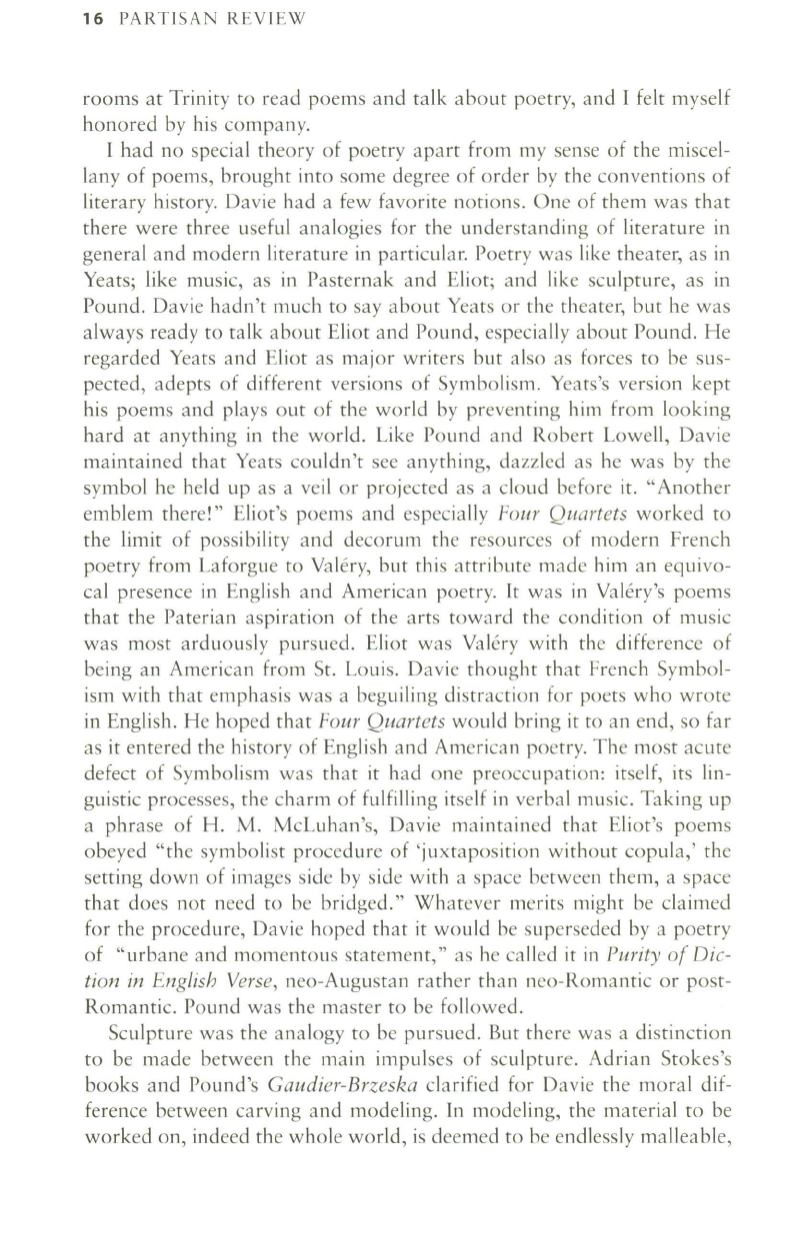
16
PARTISAN REVIEW
rooms at Trinity to read poems and talk about poetry, and I felt myself
honored by his company.
I had no special theory of poetry apart from my sense of the miscel–
lany of poems, brought into some degree of order by the conventions of
literary history. Davie had a few favorite notions. One of them was that
there were three useful analogies for the understanding of literature in
general and modern literature in particular. Poetry was like theater, as in
Yeats; like music, as in Pasternak and Eliot; and like sculpture, as in
Pound. Davie hadn't much to say about Yeats or the theater, but he was
always ready to talk about Eliot and Pound, especially about Pound. He
regarded Yeats and Eliot as major writers but also as forces to be sus–
pected, adepts of different versions of Symbolism. Yeats's version kept
his poems and plays out of the world by preventing him from looking
hard at anything in the world. Like Pound and Robert Lowell, Davie
maintained that Yeats couldn't see anything, dazzled as he was by the
symbol he held up as a veil or projected as a cloud before it. "Another
emblem there!" Eliot's poems and especially
Four Quartets
worked to
the limit of possibility and decorum the resources of modern French
poetry from Laforgue to Valery, but this attribute made him an equivo–
cal presence in English and American poetry.
It
was in Valery's poems
that the Paterian aspiration of the arts toward the condition of music
was most arduously pursued. Eliot was Valery with the difference of
being an American from St. Louis. Davie thought that French Symbol–
ism with that emphasis was a beguiling distraction for poets who wrote
in English. He hoped that
Four Quartets
would bring it to an end, so far
as it entered the history of English and American poetry. The most acute
defect of Symbolism was that it had one preoccupation: itself, its lin–
guistic processes, the charm of fulfilling itself in verbal music. Taking up
a phrase of H. M. McLuhan's, Davie maintained that Eliot's poems
obeyed "the symbolist procedure of 'juxtaposition without copula,' the
setting down of images side by side with a space between them, a space
that does not need to be bridged." Whatever merits might be claimed
for the procedure, Davie hoped that it would be superseded by a poetry
of "urbane and momentous statement," as he called it in
Purity of Dic–
tion in English Verse,
neo-Augustan rather than neo-Romantic or post–
Romantic. Pound was the master to be followed.
Sculpture was the analogy to be pursued. But there was a distinction
to be made between the main impulses of sculpture. Adrian Stokes's
books and Pound's
Gaudier-Brzeska
clarified for Davie the moral dif–
ference between carving and modeling. In modeling, the material to be
worked on, indeed the whole world, is deemed to be endlessly malleable,


